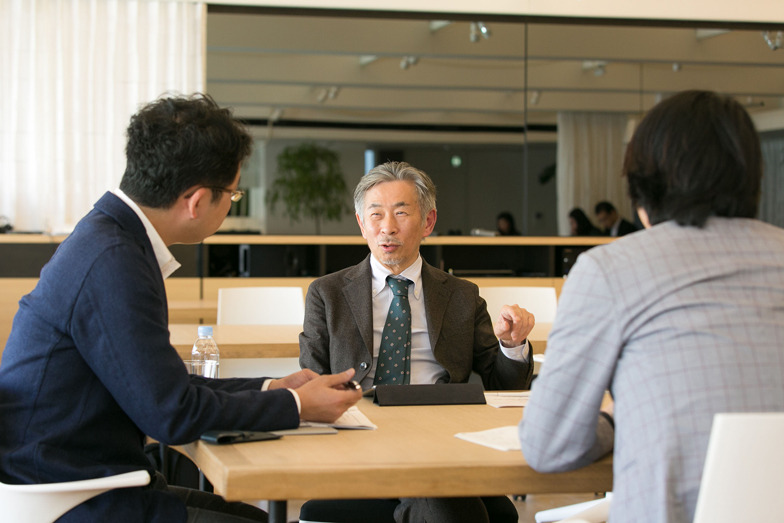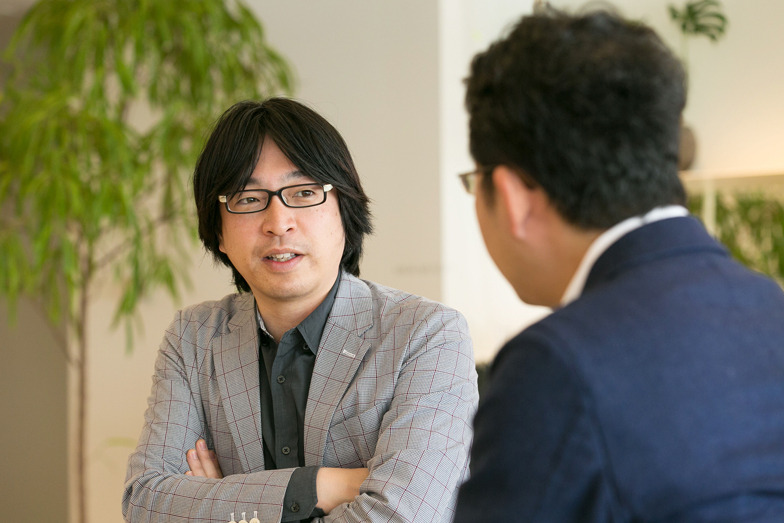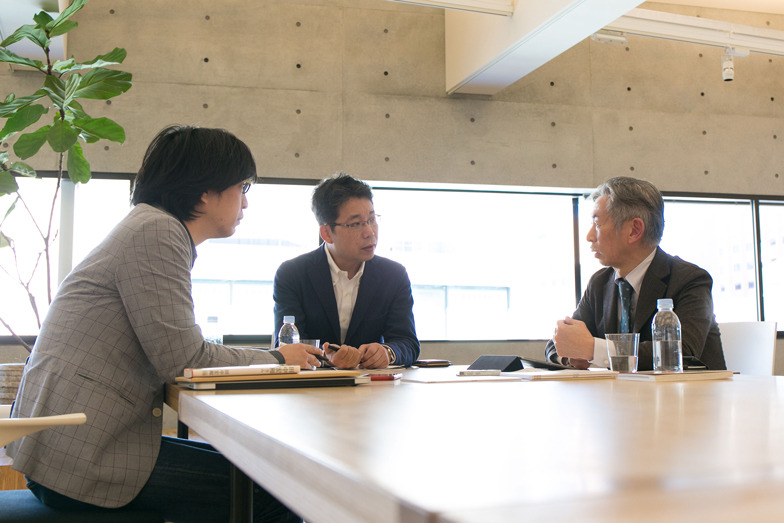"Co-Creation" refers to an approach where new value is generated through dialogue with diverse stakeholders. Derived from the meaning of "creating together," it is also called "kyōsō" (共創). The co-creation portal site "cotas," operated by Dentsu Inc. and Infobahn, held the third "Japan Co-Creation Awards 2014" to honor outstanding examples of co-creation. This series examines co-creation trends and movements through the lens of award-winning cases and judges' perspectives.
Continuing from last time, the three judges—Mr. Noboru Konno, representative of KIRO (Knowledge Innovation Research Institute); Mr. Ryusuke Koyama, whose hack series including 'IDEA HACKS!' is widely supported by business professionals; and Mr. Hirokazu Tanaka of Dentsu Inc.—held a wide-ranging discussion. They explored themes such as the nature of workshops, scenario planning, and design thinking, occasionally touching on the hippie movement and Zen philosophy.

The Role of Art and Design
Koyama: This ties back to our opening discussion. Workshops can be exciting and fun, but when it comes to implementation, people often say, "It's really difficult after all." The gap between those permissive spaces like Future Centers and the reality of implementation within organizations is vast. Bridging the gap from idea to execution is incredibly difficult. I often say that "reproducible things" belong to science, while the role of art is to "introduce fluctuations." Artists create outrageous expressions that shake up common sense in a stable society.
I believe workshops serve a similar role. And what comes after "art" is "design." How do we translate the "artistic insights" created by artists into designs for the real world? Abstract art, born in the early 20th century, took designers a hundred years to integrate into interiors and fashion. If we consider "design thinking" as the role of translating insights into action, it becomes a very practical concept.
Tanaka: "The meeting was fun, but when it came to the execution plan..." – this is a common story even in advertising agencies. When we see design as the act of giving form or putting ideas into action, there's still a misunderstanding about the word "design" itself. Some people still associate it with something superficial or cosmetic. But it's absolutely true that design is deeply involved in execution, realization, and materialization. Turning enjoyable meetings into tangible reality. It's crucial for the visionaries and the executors to join forces and create something new.
Konno: Recently, I had an interesting conversation with Danish design educators. They said, "Design thinking is important, but we're actually already moving on to the next phase." Current design thinking has its roots in the Bauhaus. Before the Bauhaus, there were traditional art schools like the Beaux-Arts. The Beaux-Arts approach was sufficient until the advent of the industrial society. But with the rise of the industrial and information societies, Bauhaus design spread.
Now, as the 20th-century industrial and information societies reach their limits and we enter what could be called the era of the next environmental revolution, what is the new role for designers? It's that deviation we've mentioned repeatedly today. So-called disruptive innovation, changing people's behavior. Current design thinking still teaches things like "Come up with an idea, then make a prototype" or "Make a prototype, then get feedback," retaining a somewhat planning-oriented feel.
What Danish designers are challenging is this: if you have a purpose, just get into the field and try to gain something through trial and error. And what they're researching now is making things by hand – woodworking, clay work. They see that as the origin. They literally immerse themselves in the situation, kneading clay or carving wood together. Engaging in these primal activities on-site sparks a kind of hacking, where fragments of the next future emerge. I was deeply moved by their attempt to use design in this way.

Tanaka: That's a very thought-provoking point. Certainly, with a Bauhaus-like philosophy of "Less is more," the focus is on how to simplify and reproduce that simplicity. But what lies beyond that might very well emerge from the kind of collaborative play you just described.
Making Purpose Manifest from Place-Based Emotion
Koyama: In a similar vein, what I've been focusing on lately is improvisation. It's an approach where you abandon all planning and focus entirely on what happens in this very moment. In improvisational theater, four or five performers come out, receive roles from the audience, and then, with no preparation, build a story based on those roles. The audience watches with bated breath, wondering "Will this really work?", becoming deeply engrossed. It's far more exciting than watching conventional theater. The sense of unity in that theater is incredible. This structure is essential for future business.
Traditional industrial products were like actors presenting a predetermined story to customers, saying, "Here! Enjoy this story." Customers then watched it like playing a DVD. Now, companies—the actors—need to observe user reactions, change the story, and continuously develop new elements.
Take GoPro cameras, for example. They didn't just appear in their current form overnight. They launched with the idea, "Wouldn't it be cool if something like this existed?" People started using them in all sorts of ways, which led to more accessories being developed. As more accessories emerged, people began experimenting with even more filming techniques. GoPro then showcased these as "Today's Movie" for everyone to see. The interaction between the company and users has become highly improvisational. I believe companies need to engage more proactively with their customers.
Tanaka: Companies themselves need to adopt an attitude of enjoying this process.
Koyama: What's fascinating about improvisation is that it starts with no purpose whatsoever. When you're doing something without a goal, at some point, you realize, "Wait, are we actually aiming for this?" The purpose self-organizes. Like introducing a foreign substance into nothingness to form a crystal, a narrative emerges. Improvisers step onto the stage with the conviction that "something will definitely happen."
Now, look at companies today—they're in a state of "We can't step in unless we know what's coming beforehand." The most crucial thing for sparking improvisation is "investing time even when you don't know what will happen." It's about creating connections. Take Mr. Tanaka—despite his busy schedule, he continues the Hirokazu Tanaka Movement, investing time in it even when others don't understand. This initial "investment" is vital. And fundamentally, what's needed is that sense of foreignness, that feeling of deviation.
Tanaka: In 1994, Tanaka Hirokazu was the first-round draft pick for the Kintetsu Buffaloes. Feeling as if I'd been chosen first inspired me to start this. Last year, I finally established the General Incorporated Association "Tanaka Hirokazu Society." When drafting its articles, one principle was "promoting the value of fortuitous human bonds." I discovered the purpose after the fact.
Konno: It's not that there's absolutely no purpose; it's more like a vague, indistinct idea in your mind. As you keep going, it gradually takes shape. It's not aimless; it feels like something latent is being brought into being.
Koyama: In improvisation, we consider the purpose to reside within the space or the situation itself. When an improviser steps onto a theatrical stage, if they already carry a preconceived purpose within themselves, they end up trying to control the situation—thinking things like, "This time, I'll make it a moving story." Holding such intentions is what strips away improvisation the most. It's crucial to understand that the purpose lies within this space, encompassing the stage, the performers, and the audience.
An interesting aspect of Japanese language is the ambiguity when Murasaki Shikibu writes "itokashii" – it's unclear who finds it "strange." In English, you'd write "He found this situation interesting." But in Japanese, "itokashii" leaves it ambiguous: did the author feel it, did a character feel it, or is it a question posed to the reader, "Don't you find it strange?" It's a spatial feeling that includes the reader. The feeling of "itokashi" exists in that space, and whether it's the author, a character, or the reader, they feel it. Catching this spatial feeling, catching the ineffable, is actually what hippies gained from Eastern thought. How to make the purpose manifest from this spatial feeling. That is the major process of improvisation.

Tanaka: I once worked on a live improvisation performance by Ryuichi Sakamoto and Otomo Yoshihide. Naturally, the pieces were completely different between rehearsal and the actual show. After it ended, I asked, "How did you decide on the ending?" Both of them could only answer, "Somehow." Each was playing autonomously, yet there was this shared sense of the space—something both felt, or perhaps the audience felt too. Sakamoto would suddenly stop playing the piano and start banging on it, veering further and further off course. But by the end, everyone shared this recognition: "Ah, it's about time to finish. It's over." It's incredible, isn't it?
Konno: In workshops, the facilitator often ends up being the main focus. This is completely different, isn't it? It's almost the exact opposite of what you just described.
Tanaka: Even in group interviews, the most interesting and revealing moments happen when it's not the moderator controlling things, but when it's literally group dynamics—when everyone is chatting away together.
Konno: I wish people would stop falling into that planned-out, predictable pattern of wrapping things up with "Thank you for your wonderful insights today" (laughs). I think co-creation for innovation doesn't come from one-off events like that, but from creating everyday spaces that foster new discoveries and serendipity.
Tanaka: Thinking about it that way, how much of our work is planned harmony? There are places where we do administrative work just for the sake of planned harmony.
Koyama: Predictability is essentially an exchange of equivalent value. You think, "I received this much money, so I'll produce this much output." On the other hand, investing your time in something without a clear purpose, something undefined, is a "gift." You never know what you'll get back from a gift. Earlier we discussed why workshops often fail—it's because people constantly think, "Will I get something in return for this?" in terms of equivalent exchange. The crucial mindset is to hold onto a vague yet firm conviction: "This will definitely yield something in the future. By giving here and now, things start moving spontaneously, and something enjoyable will surely come later."
Tanaka: I totally get that feeling. It's like thinking of it as the "ticket price" for seeing or experiencing something interesting, right? It's not about the logic of equivalent exchange; what matters is service or gift-giving—offering from yourself, giving without hesitation.
Koyama: Service and gift-giving are art itself. Artists create works without knowing if they'll be appreciated. There's art as a gift, and then you need the design process to make that gift work. What a "designer" in the broader sense should do is figure out how to connect those spontaneously emerging ideas to a concept. And what's crucial here is that it can't just be about what you want to do; it has to be a concept that captures the purpose emerging from that moment. Otherwise, neither the audience nor the other actors will be convinced.
Tanaka: Alongside conceptualization, another crucial element is design for continuity. In the case of the Tanaka Hirokazu movement, I first became aware of the existence of someone with the same name in 1994. I met the first Tanaka Hirokazu in person in 2003, and since then, I decided to meet one Tanaka Hirokazu every year. And I decided that when we meet, it must always be at a round table in a Chinese restaurant near Tokyo Station. The thing is, I don't know beforehand where the Tanaka Hirokazu I'm meeting lives. But saying "near Tokyo Station" is something anyone understands, it feels fair, and it's hard to complain about. And whether someone is vegetarian or only eats meat, Chinese food has enough variety on the menu that it should be fine. I decided to meet one person each year, and then one time it was featured on TV and suddenly there were a lot more. But until then, I always stuck to this style. I kept going, determined to maintain this design.
Koyama: Defining your audience makes your purpose clear. When you're inside a company, your audience is only about five meters in radius, right? Like, "What will the department head think?" or "The section chief might oppose this." If you're performing on a five-meter stage, that's the only performance you can give. But as your own knowledge expands, you start to feel a sense of responsibility towards the industry – like carrying the weight of the advertising industry on your shoulders. That's when your stage expands to the entire advertising industry. Then your audience changes too. Even doing similar work within the same company, your sense of what matters completely shifts. When crafting the story of your personal life—this improvisational drama—your audience changes with the times. And depending on which audience you focus on, your life itself changes dramatically. The ultimate audience is the heavens watching over you. It's through the auspices of this audience that grand visions unfold.
Tanaka: Regarding the Hirokazu Tanaka Movement, a certain business executive once told me, "It must be hard to know when to stop." But when I heard that, I replied for the first time, "I'll make it my lifelong hobby." I think it's a great hobby – even at 70 or 80, people still travel far to meet Hirokazu Tanaka. Thank you for the wonderful conversation today (laughs).









